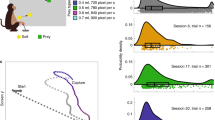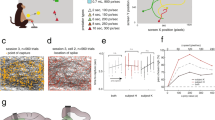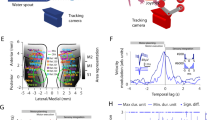Abstract
In terms of evolution, the strategy of catching prey would have been an important part of survival in a constantly changing environment. A prediction mechanism would have developed to compensate for any delay in the sensory-motor system. In a previous study, “proactive control” was found, in which the motion of the hands preceded the virtual moving target. These results implied that the positive phase shift of the hand motion represents the proactive nature of the visual-motor control system, which attempts to minimize the brief error in the hand motion when the target changes position unexpectedly. In our study, a visual target moves in circle (13 cm diameter) on a computer screen, and each subject is asked to keep track of the target’s motion by the motion of a cursor. As the frequency of the target increases, a rhythmic component was found in the velocity of the cursor in spite of the fact that the velocity of the target was constant. The generation of a rhythmic component cannot be explained simply as a feedback mechanism for the phase shifts of the target and cursor in a sensory-motor system. Therefore, it implies that the rhythmic component was generated to predict the velocity of the target, which is a feed-forward mechanism in the sensory-motor system. Here, we discuss the generation of the rhythmic component and its roll in the feed-forward mechanism.
Similar content being viewed by others
Explore related subjects
Discover the latest articles, news and stories from top researchers in related subjects.References
Ishida F, Sawada Y (2004) Human hand moves proactively to an external stimulus: an evolutional strategy for minimizing transient error. Phys Rev Lett 93:168105
Carl JR, Gellman RS (1987) Human smooth pursuit: stimulus-dependent responses. J Neurophysiol 57:1446–1463
Rosen R. Anticipatory systems. Pergamon, London
Author information
Authors and Affiliations
Corresponding author
Additional information
This work was presented in part and was awarded the Young Author Award at the 14th International Symposium on Artificial Life and Robotics, Oita, Japan, February 5–7, 2009
About this article
Cite this article
Hayashi, Y., Tamura, Y., Sugawara, K. et al. Roll of the rhythmic component in the proactive control of a human hand. Artif Life Robotics 14, 164–167 (2009). https://doi.org/10.1007/s10015-009-0730-x
Received:
Accepted:
Published:
Issue Date:
DOI: https://doi.org/10.1007/s10015-009-0730-x




